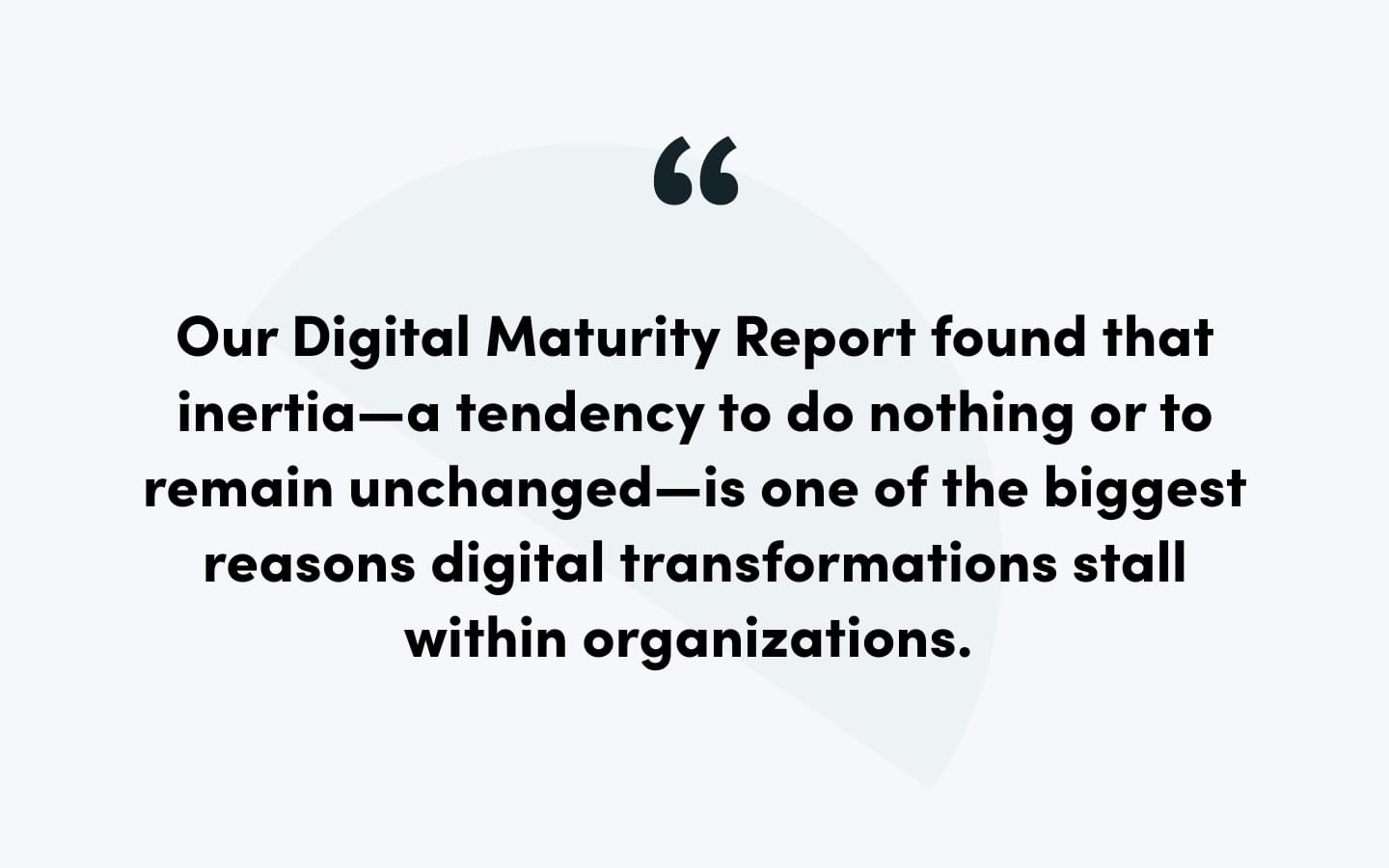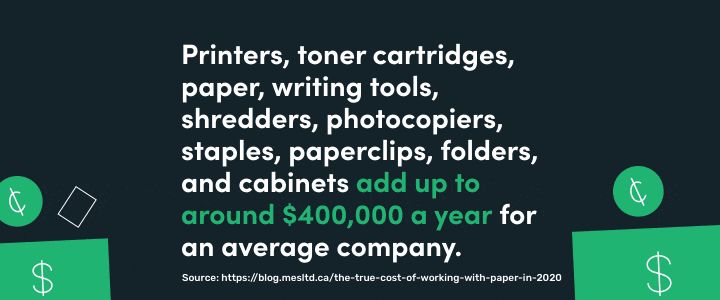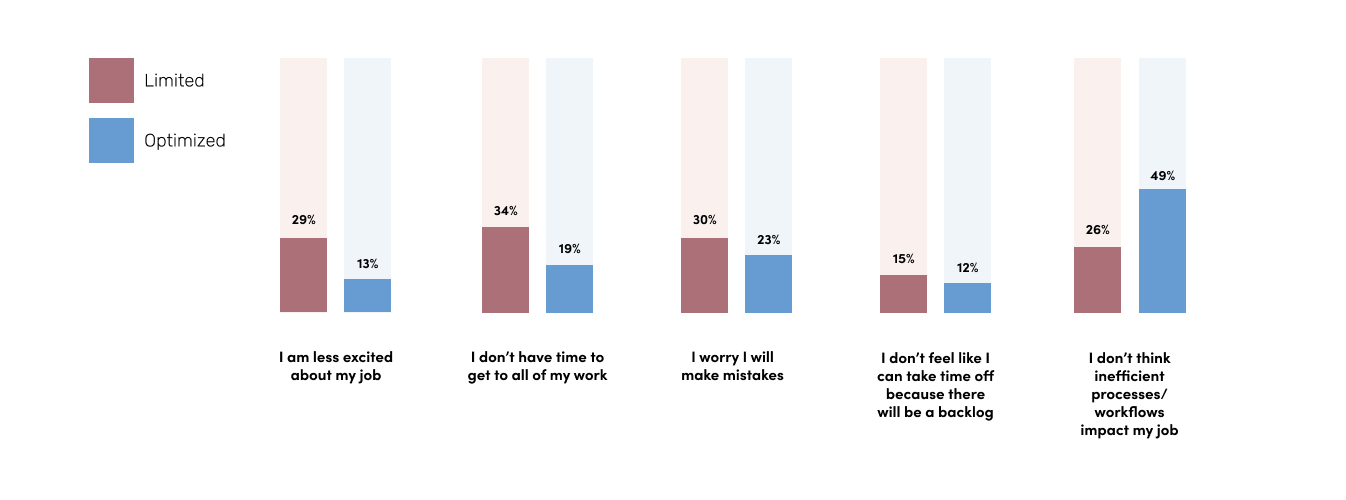Is Big Paper getting in the way of your productivity and happiness at work?
You can be honest with us.
Because behind the scenes, Big Paper is loving every moment they steal from you.
In fact, they have a redundancy division dedicated to keeping you stuck in paper processes.
Jokes aside, we know that paper is a big problem for a lot of organizations. Our 2022 State of Digital Maturity report found that 85% of organizations are using paper in some capacity. Respondents identified legal documents, healthcare records, insurance processing, and student documentation as workflows within their organizations that still include paper processes.
We know paper is inefficient. As Denise Davis said on a recent episode of Formstack’s Practically Genius podcast, “it’s completely impractical.”
Yet many companies are still reliant on paper processes. Why? Because they continue to do things the way they’ve always been done. We found that inertia—a tendency to do nothing or to remain unchanged—is one of the biggest reasons digital transformations stall within organizations.

If you’re still struggling to convince your organization to get rid of paper for good, we’re ready to help. Here are five compelling reasons to go paperless—with data and stats leaders can’t ignore.

Listen Now: Hear Denise’s tips on how to convince your org it’s time to eliminate paper by listening to her podcast episode Why Paper Is Completely Impractical now.
1. Paper Costs Add Up
Big Paper costs big money.
Organizations that have already gone paperless understand this. A recent survey by Keypoint Intelligence found that cost reduction was the top driver for increasing paperless adoption.
Printers, toner cartridges, paper, writing tools, shredders, photocopiers, staples, paperclips, folders, and cabinets add up to around $400,000 a year for an average company.

What could your company be doing with an extra $400,000? From hiring additional employees to finally investing in some long sought-after tech, that large chunk of change could radically transform an organization.
As more leaders begin focusing on how to recession proof their business, budgets and spend will come under immense scrutiny. Would your organization feel comfortable knowing it was leaving $400,000 on the table because of inefficient paper processes? Probably not.
Learn More: The Problem With Paper: Statistics That Will Blow Your Mind
2. Customers Don't Want Paper
People just don’t like paper. And we have data to back that up: Our 2022 State of Digital Maturity report found that 86% of respondents prefer digital forms over paper ones.
Paperwork consistently came up in write-in answers as a major frustration for people. They told us that paper-based processes are cumbersome, repetitive, and frustrating.
Here’s a quick look into what your customers might be saying about your paper processes:

The message resonates across all industries: customers are sick and tired of paper.
3. Paper Is Wasteful
As you can probably guess, paper isn’t the best for the environment.
In fact, pulp and paper is the third-largest air, water, and land polluter among all industries in Canada and the U.S.
But paper also causes waste problems within an office. On average, companies completely lose around 7.5% of all their paper documentation.
It’s been estimated that 45% of paper printed in offices ends up trashed by the end of the day, and companies spend more than $120 billion a year on printed forms—most of which outdate themselves within three months’ time.
Unfortunately, the waste doesn’t end at physical paper and money. There’s also the huge waste of time created by paper processes. Denise explains it perfectly in her Practically Genius podcast episode:
Reviewing handwriting, rekeying data, and performing manual data transfers forces employees to waste precious time. It takes them away from their most impactful work, which further sets your organization back.

Did you know? Our State of Digital Maturity report found that 51% of workers spend at least two hours per day on repetitive tasks and inefficient processes.
4. Data Collected Through Paper Isn't Accurate
Businesses run on data.
But paper has a way of destroying the quality of data captured. Here are just some of the issues with collecting data through paper:
- Handwriting can be illegible.
- There's no way to require answers.
- Formatting cannot be controlled.
- It's hard to correct errors.
- Directions cannot be enforced.
- Rekeying data allows for mistakes.
All these issues lead to poor data hygiene. Over time, these small, one-off mistakes can pile up and create data chaos within your organization.
Denise knows this from experience. Below, she explains how something as small as not being able to standardize addresses through paper forms led to a massive data emergency.
Don’t let unruly data from a paper form destroy your organization’s data cleanliness. As Denise pointed out, digitizing your data collection systems provides much more control over the quality of data you bring in.
Read Next: How to Eliminate Paper for Good
5. Paper Negatively Impacts Employee Morale
Did you know that 77% of organizations report it’s challenging to retain talented employees?
The good news is that it doesn’t have to be this way. Our State of Digital Maturity report found that organizations who have digitized the most struggle the least with retaining employees. In fact, 33% of these optimized organizations report it’s not challenging at all to retain employees.
But wait, there’s more!
Employees at these digitized organizations are generally happier, less stressed, and more productive. When comparing the most digitally mature organizations (Optimized) to the least (Limited), the negative impact paper-based processes and manual workflows have on employee morale becomes clear.

As businesses try to recover from the Great Resignation, putting a focus on employee experience is more important than ever. Eliminating paper and investing in digitization can help organizations not only retain employees, but keep them happier and more engaged.

It’s Time to Get Rid of Paper
Big Paper has weaseled its way into nearly every industry—from insurance to healthcare to education to finance—leaving us all with a long and frustrating paper trail to navigate. We’re over it, and it seems like you are too.
One of the five compelling reasons above must be enough to sway your organization that it’s time to put an end to paper. Let’s stop the inefficiencies, errors, and redundancies caused by Big Paper for good!
Denise Davis helped an organization of 28,000 employees and 250 locations eliminate paper. How did she do it? Find out now by listening to her Practically Genius podcast episode Why Paper Is Completely Impractical now.











